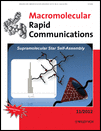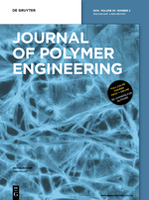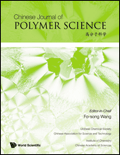
ACS Macro Letters
Scope & Guideline
Unleashing the Potential of Polymers and Plastics
Introduction
Aims and Scopes
- Polymer Synthesis and Characterization:
The journal covers various synthesis techniques, including controlled radical polymerization, ring-opening polymerization, and photopolymerization, while also emphasizing the characterization of synthesized polymers to understand their properties and performances. - Macromolecular Design and Functionality:
Research that focuses on the design of new macromolecular architectures, including block copolymers, dendritic polymers, and responsive materials, is a core area. The journal highlights the relationship between structure and functionality, particularly in applications such as drug delivery and sensors. - Materials for Energy and Environment:
Papers exploring the development of polymeric materials for energy storage, conversion, and environmental remediation are prominent. This includes advancements in polymer electrolytes for batteries and fuel cells, as well as biodegradable and recyclable materials. - Biomaterials and Biomedical Applications:
The journal features studies on the use of polymers in biomedical applications, including drug delivery systems, tissue engineering, and antimicrobial materials, emphasizing the interaction of these materials with biological systems. - Nanostructured Polymers and Composites:
Research on the synthesis and application of nanostructured polymers, including nanocomposites and hybrid materials, is a significant focus. This includes the exploration of polymer-based nanomaterials for various applications, from catalysis to photonics.
Trending and Emerging
- Sustainable and Biodegradable Polymers:
There is an increasing focus on developing sustainable materials that are biodegradable or recyclable, driven by environmental concerns and regulatory pressures. Research in this area seeks to create functional materials that minimize ecological footprints. - Smart and Responsive Polymers:
Research on stimuli-responsive polymers that can change properties in response to environmental stimuli (e.g., pH, temperature, light) is rapidly growing, indicating a shift toward functional materials for applications in drug delivery and sensors. - Polymer Nanocomposites:
The integration of nanoparticles into polymer matrices to enhance mechanical, thermal, and electrical properties is gaining attention, especially in the context of advanced materials for electronics and energy applications. - Biomimetic and Bioinspired Materials:
There is a trend toward developing materials that mimic biological systems, particularly in the context of biomedical applications. This includes hydrogels, scaffolds for tissue engineering, and materials that facilitate cell adhesion and growth. - Digital Fabrication and 3D Printing of Polymers:
The application of advanced digital fabrication techniques, including 3D printing and additive manufacturing, is becoming more prevalent in polymer research, allowing for the creation of complex structures with tailored properties.
Declining or Waning
- Traditional Polymer Processing Techniques:
There has been a noticeable reduction in papers focusing solely on conventional polymer processing methods like extrusion and molding, as researchers now often explore more innovative or hybrid approaches. - Non-Responsive Conventional Polymers:
Research on basic, non-responsive polymer systems is declining in favor of materials with dynamic, stimuli-responsive properties, reflecting a broader trend toward functional and adaptive materials. - Chemicals from Fossil Fuels:
Studies focused on the synthesis and application of polymers derived exclusively from petrochemical sources are becoming less prominent, as there is a growing emphasis on sustainability and the use of bio-based feedstocks. - Basic Polymer Physics:
While foundational studies in polymer physics remain important, there is a noticeable shift toward applications and interdisciplinary approaches, leading to fewer publications in purely theoretical or basic experimental physics of polymers.
Similar Journals

Polymer Reviews
Shaping the future of polymer applications.Polymer Reviews, published by Taylor & Francis Inc, is an esteemed journal dedicated to the intricate and evolving field of polymer science. With its ISSN 1558-3724 and E-ISSN 1558-3716, the journal has established a significant presence among researchers and practitioners alike, evidenced by its impressive categorization in the Q1 quartiles across multiple disciplines, including Biomedical Engineering, Materials Chemistry, and Renewable Energy. Since its inception in 2006 and continuing through 2024, Polymer Reviews has consistently aimed to advance the knowledge base of polymer applications and innovations, providing a platform for comprehensive review articles that stimulate further research and inspire practical solutions. The journal, ranking within the top percentile across several Scopus categories, underscores its impact and relevance in a rapidly developing scientific landscape. Though not an open-access journal, it remains a vital resource for those invested in the future of materials science and engineering.

MACROMOLECULAR RAPID COMMUNICATIONS
Accelerating Insights in Macromolecular ScienceMACROMOLECULAR RAPID COMMUNICATIONS, published by WILEY-V C H VERLAG GMBH in Germany, is an esteemed journal dedicated to the rapid dissemination of high-quality research in the fields of materials chemistry, organic chemistry, and polymers and plastics. With a remarkable 2023 impact factor securing its place in the prestigious Q1 category across three key disciplines, the journal ranks impressively within the top quartiles of the Scopus metrics, standing at 36th in organic chemistry and 35th in polymers and plastics. Although the journal does not offer open access options, its informative depth and innovative research make it an invaluable resource for researchers, professionals, and students seeking to stay abreast of the latest developments in macromolecular science. Covering a broad spectrum of topics from fundamental research to applications, MACROMOLECULAR RAPID COMMUNICATIONS aims to foster collaboration and inspire further advancements within the scientific community.

MACROMOLECULAR BIOSCIENCE
Unveiling New Horizons in Biomaterials and BioengineeringMACROMOLECULAR BIOSCIENCE, published by WILEY-V C H VERLAG GMBH, is a leading journal in the fields of bioengineering, biomaterials, biotechnology, materials chemistry, and polymers and plastics. With a convergence of scientific inquiry since its inception in 2001, the journal has established itself as a vital resource for researchers and professionals exploring the interface of molecular sciences and biosystems. It boasts impressive Scopus rankings, including Q1 status in multiple categories, reflecting its significant contribution to advancing knowledge and innovation in the polymer and biomaterials domains. While the journal does not currently offer open access options, its rigorous peer-review process ensures the publication of high-quality research that fuels academic discourse. Positioned in Weinheim, Germany, MACROMOLECULAR BIOSCIENCE aims to bridge theoretical understanding with practical applications, making it an essential reference for students, academics, and industry practitioners dedicated to the evolving landscape of macromolecular bioscience.

E-POLYMERS
Transforming Ideas into Solutions in Polymer ScienceE-Polymers, an esteemed journal published by De Gruyter Poland Sp. z o.o., serves as a vital platform for advancing knowledge in the fields of chemical engineering, polymer science, and theoretical chemistry. With its Open Access policy since 2019, researchers from around the globe can freely access and disseminate groundbreaking findings that span the convergence of diverse disciplines, making it an indispensable resource for both academia and industry. The journal is recognized for its significant impact, reflected in its Q2 ranking in Chemical Engineering, Physical and Theoretical Chemistry, and Polymers and Plastics categories in 2023. Its impressive Scopus rankings further solidify its position, showcasing a percentile rank of 70th and above across major categories. With a publication history extending from 2001 to 2024, E-Polymers continually addresses pressing challenges within the polymer research community, fostering innovation and collaboration among researchers, professionals, and students eager to contribute to the evolving landscape of materials science.

POLYMER JOURNAL
Exploring the Dynamics of Polymers and PlasticsPOLYMER JOURNAL, published by SpringerNature in the United Kingdom, is a premier academic platform dedicated to the field of polymer science. Since its inception in 1971, this journal has become an essential resource for researchers and professionals interested in the latest advancements in materials chemistry, polymers, and plastics. With its robust H-index and a consistent ranking in the top quartiles of its categories—Q2 in both Materials Chemistry and Polymers and Plastics—POLYMER JOURNAL demonstrates a strong impact in the scientific community. It holds significant recognition in Scopus rankings, occupying the 68th percentile in Materials Chemistry and the 67th percentile in Polymers and Plastics. The journal's commitment to publishing high-quality research articles enables it to serve as a key reference point for innovative studies, theoretical developments, and practical applications in polymer science. Although it is not an open-access journal, researchers and students gain valuable insights through its extensive archives and rigorous peer-reviewed content, making POLYMER JOURNAL a vital source of knowledge for anyone engaged in this dynamic field.

JOURNAL OF POLYMER ENGINEERING
Elevating Knowledge in Chemical Engineering.JOURNAL OF POLYMER ENGINEERING, published by Walter de Gruyter GmbH, stands as a pivotal platform in the field of polymer science and engineering. With an ISSN of 0334-6447 and an E-ISSN of 2191-0340, this journal has been a vital contributor to the academic landscape since its inception, spanning publications from 1981 to 2024. As a recognized entity in the realms of Chemical Engineering, Materials Chemistry, and Polymers and Plastics, it holds a respectable position in Q3 quartile rankings according to the latest assessments. The journal is positioned to promote the exchange of cutting-edge research findings, technological advancements, and critical reviews that address the complexities of polymer application and innovation. Researchers and professionals will find a wealth of information, from experimental methodologies to theoretical analyses, all designed to inspire and elevate the current understanding of polymer engineering. By fostering collaboration and dissemination of knowledge, the JOURNAL OF POLYMER ENGINEERING remains crucial for advancing research and education in its specialized domains.

ACTA POLYMERICA SINICA
Shaping the Landscape of Polymer Innovation GloballyACTA POLYMERICA SINICA is a distinguished journal published by SCIENCE PRESS, specializing in the multifaceted disciplines of Chemical Engineering, Chemistry, and Polymers and Plastics. Established in 1996, this peer-reviewed journal provides a critical platform for the dissemination of cutting-edge research and advancements within these fields, promoting innovation and knowledge-sharing among researchers and professionals globally. With its presence in the highly competitive Q3 quartile rankings as of 2023, the journal demonstrates a commitment to maintaining rigorous academic standards while supporting the evolving landscape of polymer science. Operating from Beijing, China, the journal caters to a broad readership and emphasizes the importance of interdisciplinary collaboration in addressing contemporary challenges in material science. Although it does not offer open access, ACTA POLYMERICA SINICA remains a vital resource for scholars seeking to enhance their understanding and contribute valuable insights to the field.

ADVANCES IN POLYMER TECHNOLOGY
Transforming Research into Real-World Applications.ADVANCES IN POLYMER TECHNOLOGY is a premier open-access journal that has been at the forefront of innovation in the field of polymer science and engineering since its inception in 1981. Published by WILEY-HINDAWI, this journal serves as a vital platform for researchers, professionals, and students alike, facilitating the dissemination of cutting-edge research and applications in chemical engineering, organic chemistry, and polymers and plastics. With an impact factor that signifies its relevance and quality, the journal has achieved notable rankings, including Q2 in Chemical Engineering, and ranks within the top 30% of its category in multiple disciplines as of 2023. ADVANCES IN POLYMER TECHNOLOGY has embraced open-access publishing since 2019, ensuring that research findings are widely available to the global academic community. With its comprehensive coverage of topics related to polymer technology, this journal not only fosters scholarly exchange but also aims to bridge the gap between fundamental research and practical applications, thereby contributing significantly to advancements in materials science.

CHINESE JOURNAL OF POLYMER SCIENCE
Innovative Research at the Forefront of Polymer ScienceThe CHINESE JOURNAL OF POLYMER SCIENCE, published by SPRINGER, stands as a premier periodical in the realm of polymer science, showcasing cutting-edge research and technological advancements since its inception in 1985. With an impressive impact factor reflecting its significance in the field, this journal is categorized in the top quartiles (Q1) of Chemical Engineering, Organic Chemistry, and Polymers and Plastics. It features a wide spectrum of innovative studies, thus serving as an essential resource for researchers, professionals, and students dedicated to understanding and advancing polymer-related technologies. The journal is indexed in Scopus, with notable rankings that highlight its influence in the disciplines of organic chemistry and materials science, making it a vital communication platform for authors around the globe aiming to disseminate impactful findings. Although not an open-access publication, the journal ensures robust accessibility through institutional subscriptions and partnerships, further emphasizing its commitment to the advancement of polymer science.

ACS Polymers Au
Elevating the conversation in polymer applications.ACS Polymers Au, published by the American Chemical Society, is an innovative open-access journal dedicated to advancing the field of polymer science. Launched in 2021, this journal offers researchers, professionals, and students a platform to publish and access high-quality research articles without the barrier of paywalls, thereby fostering greater collaboration and knowledge sharing within the scientific community. With a focus on polymers and plastics, as well as their applications in materials science and chemical engineering, ACS Polymers Au is recognized for its rigorous peer-review process and commitment to maintaining high research standards. Although currently ranked in the lower percentiles across various categories in Scopus metrics, its dynamic publication format allows for rapid dissemination of cutting-edge findings. As the journal continues to grow and evolve alongside the polymer community, it remains an invaluable resource for those aspiring to enhance their scientific understanding and contribute to the future of polymer research.